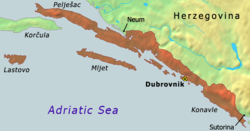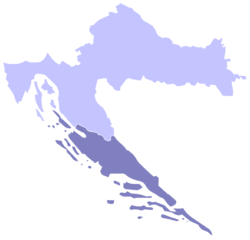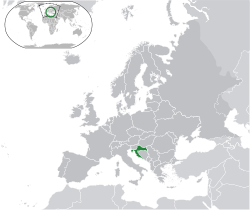Nationalistic Editing, Extremists on Wikipedia
Nationalistic Editing on Wikipedia is very much part of Wikipedia. Wikipedia itself has over the years become a gathering place for individuals with extreme views when it comes to topics dealing with Nationalism. There is no other place this is more visible than in the Croatian articles on Wikipedia. This article deals with the Croatian section of Wikipedia.
For many, Wikipedia has become the first port of call for information about anything and everything. With this in mind a crafty group of clever individuals (or organisations) can very easily manipulate historic information for their own biased-extremists Nationalistic agendas.
Quote by Ocham-London, United Kingdom:
Judging by many of edits on the Croatia related articles, they are pretty much written from a dated point of view of the former Communist Yugoslavia. Communist Yugoslav nationalistic history is all but forgotten in the West. It was the regimes policy to create a uniform state rather than a collective of peoples. The policy was one of the great historic failures of recent times. In essence Yugoslavia was a contradiction, on one hand it had the slogan Brotherhood and Unity [1][2] and on the other hand it executed Stalinist policies from the 1940s to the 1960s. Other Nationalistic conflicts within Wikipedia that are related to the Croatian region are based on ethnicity (i.e. Croatian, Serbian, Albania and Italian).
Wikipedia and Bias editing Concerning the Dalmatian region (& other Croatian articles too)
It appears that Wikipedia has problems interpreting the multicultural and multiethnic history of the Dalmatian region. There is a strong culture of editing bias that seems to prevail. This results in articles that reflect a point of view rather being encyclopaedic.
As events are unfolding, the bias tips mainly towards the propaganda of the former Communist Yugoslavia (13/12/2012). The articles reflect Nationalistic views of a Totalitarian Communist system.
Fausto Veranzio & Francesco Patrizi
The case of Fausto Veranzio (or Faust Vrančić) and Francesco Patrizi, the Venetian philosopher, is an illustration of the nationalistic warfare that is part of Wikipedia and the inaccuracy, falsehood and bias that follows as a result.
Quote by Ocham-London, United Kingdom:
Venetian Albania
Another article to mention is Venetian Albania [3] (it is also related to the Republic of Venice.) Here is an Editor's response to some very simple basic historic facts concerning the Republic of Venice and Venetian Albania:
This is typical standard Wikipedian rhetoric spin. The language can be also interpreted as a facade for other editors who are not educated in the topic at hand. Also the statement is there to create a problem where in fact there isn't an issue here at all other than that of Nationalistic extremism.
Wikipedian Editor DIREKTOR tried to remove Josip Broz Tito from Wikipedia's article "List of dictators" /Link, and is trying to create the falsehood that a mass murdering executioner was a Benevolent dictator (his speciality is totalitarian communist spin).
- A Wikipedian Editor's observation on Yugoslav Nationalistic editing and Wikipedia Admin:

House of Bona
The best example of this is the article House of Bona.[10][11] The House of Bona was a noble family from the former state of the Republic of Ragusa (with its famous city called Dubrovnik), which was part of the historic region of Dalmatia. [12]
According to some Wikipedia Editors, it was the House of Bunić. The Bunic name is a Slavic translation and is hardly used even in today’s Croatia. There was an edited war over the whole matter and eventually with the strength of references it was changed.
After World War Two the Slavicisation of the of Dalmatia (today part of Croatia) was continued as government policy under the Communist Party of Yugoslavia. All cities, towns, villages, family and peoples surnames that are not of Slavic origin were being translated.[13] The policy was firstly implemented on a large scale with the creation of the Kingdom of Yugoslavia in 1918.[14]
Dalmatia is a region of Europe with a very multicultural and multiethnic history. The population of that region is predominately Croatian but there is a strong Latin historic tradition dating back to Roman times. The forceful translation of their cultural and even at times rewriting of history is what could be termed cultural genocide. Wikipedia has a current group of editors who participating in that process.
Note: Italian and Latin languages were used extensively in Dalmatia. [15] The region also had a significant Dalmatian Italian ethnic population.[16]
Family Member Statement on Wikipedia

Update: Wikipedian Editor DIREKTOR does his Nationalistic Extremism editing by changing the article's title to House of Bunić (7/11/201). Editor Grifter72 changes House of Bunić to House of Bona (11/11/2011).
Wikipedia's Dalmatian Italians Article and biased edits
He is other example of bias editing on Wikipedia the free encyclopaedia which could be viewed as cultural genocide. The historic information below was deleted because it did not reflect the dated point of view of the former Communist Yugoslavia. According to Wikipedia in the Dalmatian Italians article (21/11/2010), history of the region started in 997 A.D. We somehow lost the history of the Roman Empire and the early Byzantine Empire. See below:
Update: The article's Roman Dalmatia section link has been returned (26/12/2010) by editor 65.9.76.25. This type of Wiki-editing is very common.
Croatisation
Removing large sections of history within the Croatisation article link
The section gets put back in and then deleted again by Wiki-Editor PRODUCER link. Pure political bias:
- Combination of Nationalistic Extremism and Neo-Communism in the editing style.
See also
- Top 10 Reasons Not to Donate to Wikipedia
- Criticism of Jimmy Wales
- Worst of Wikipedia
- The Wikipedia Point of View
- Wikipedia scandals (see also Wikipedia Vandalism Study)
- Wikipedia Vandalism
- Wikimoney-a
- Wikipedia's bias towards Dictator Josip Broz Tito and Communist Yugoslavia
- Bleiburg Massacre and Wikipedia
- Additional Info-Talk:Nationalistic Editing on Wikipedia
- Croatisation
External links
- The Wikipedia Review
- Who is Larry Sanger?
- House of Bona
- Link for Talk:House of Bona
- Cultural genocide: Rethinking Cultural Genocide Under International Law Human Rights Dialogue: "Cultural Rights" (Spring 2005) by David Nersessian.
- Croatian Institute of History Link
- How to manipulate Wikipedia, www.myisrael.org.il
Israel National News:
Notes and References
- ^ Identity Politics in the Age of Genocide: The Holocaust and Historical Representation by David Bruce MacDonald (p169)
- ^ Brotherhood and Unity was originally a policy of the Kingdom of Yugoslavia
- ^ <templatestyles src="Module:Citation/CS1/styles.css"></templatestyles>"Venetian Albania, 2011.Tue. 22 Feb. 2011". 2011. Retrieved 2011-02-22. Check date values in:
|date=(help) - ^ Venetian Albania Talk:Venetian Albania-Article scope
- ^ <templatestyles src="Module:Citation/CS1/styles.css"></templatestyles>"Wikipedia:Talk Ustase- Invasion of SFR Yugoslavia in 1941 (???), 2011.Wed. 2 Mar. 2011". 2011. Retrieved 2011-03-2. Check date values in:
|accessdate=and|date=(help) - ^ Jews, Christians, and Muslims in the Mediterranean World after 1492 By Alisa Meyuhas Ginio (p190)
- ^ The Chicago Jewish forum, Volume 23 by Benjamin Weintroub (p271)
- ^ Footprint Croatia by Jane Foster (p271)
- ^ Croatia by Michael Schuman (p82)
- ^ Age, Marriage, and Politics in Fifteenth Century Ragusa by David Rheubottom. Book overview: This book combines the insights of history and anthropology with innovative techniques such as computer simulation to investigate the relationships between politics, kinship, and marriage in the late-medieval city-state of Ragusa (present-day Dubrovnik). At its heart is a reconsideration of `office' and the ways in which ties of kinship and marriage were mobilised to build electoral success.
- ^ Our Kingdom Come The Counter-Reformation, the Republic of Dubrovnik by Zdenko Zlatar
- ^ John Everett-Healu.Dalmatia Concise Dictionary of World Place-Names. Oxford University Press. 2005. Encyclopedia.com
- ^ Balkan Babel: The Disintegration of Yugoslavia from the Death of Tito to the Fall of Milosevic by Sabrina P. Ramet. Note: Croatisation is a form of Slavicisation.
- ^ Croatisation or Slavicisation was a policy firstly implemented under the rule of the Austro-Hungarian Empire
- ^ The Early Beginnings of Formal Education - Vela Luka (beginnings of literacy and Lower Primary School 1857 – 1870):
- "Italian language was not only the official language in all public Dalmatian establishments, but also was the spoken language in a significant number of white-collar, civil service and merchant families in the cities and major markets within towns" (p.8 written in Croatian)
- ^ Concerning the Number of Italians/Pro-Italians in Dalmatia in the XIXth Century by Šime Peričić
- "It is true, then a small colony of Italians where in Sibenik, on the island of Korcula, Hvar and Vis, and other places of the province."
- ^ <templatestyles src="Module:Citation/CS1/styles.css"></templatestyles>"Dalmatian Italians" Check
|url=value (help). 2010. Retrieved 2010-11-21. Check date values in:|date=(help) - ^ Društvo književnika Hrvatske, Bridge, Volume 1995, Nubers 9-10, Croatian literature series - Ministarstvo kulture, Croatian Writer's Association, 1989
- ^ Hrvoje Mezulić i Romano Jelić [1] (croatian)]
- ^ Nenad Vekarić, Pelješki rodovi, Vol. 2, HAZU, 1996 - ISBN 9789531540322
- ^ Jasminka Udovički and James Ridgeway, Burn this house: the making and unmaking of Yugoslavia
- ^ Several estimates of the Istrian-Julian exodus by historians:
- Vladimir Žerjavić (Croat), 191,421 Italian exiles from Croatian territory.
- Nevenka Troha (Slovene), 40,000 Italian and 3,000 Slovene exiles from Croatian and Slovenian territory.
- Raoul Pupo (Italian), about 250,000 Italian exiles
- Flaminio Rocchi (Italian), about 350,000 Italian exiles
- The mixed Italian-Slovenian Historical Commission verified 27,000 Italian and 3,000 Slovene migrants from Croatian and Slovenian territory.
- ^ Luciano Monzali, Antonio Tacconi e la comunità italiana di Spalato, Società dalmata di storia patria.
- ^ a b <templatestyles src="Module:Citation/CS1/styles.css"></templatestyles>Darko Darovec. "THE PERIOD OF TOTALITARIAN RÉGIMES - The Reasons for the Exodus".
- ^ Liliana Ferrari, Essay on Raoul Pupo, pag. 5, Rizzoli, Gorizia 2005
- ^ Sabrina P. Ramet, Balkan babel: the disintegration of Yugoslavia from the death of Tito, Westview Press, 2002 «...and since the sixties, those of the rest of Croatia. The Istrian Democratic Party demanded autonomy for Istria, as a protection against "the forcible Croatization of Istria" and an imposition of a coarse and fanatical Croatism[...] Furio Radin argued that such autonomy was vital for the cultural protection of the Italian minority in Istria.»
- ^ «Pola, no to Italian chorus in St. Anthony church» in "Difesa Adriatica" year XIV n.5 - may 2008
- ^ Alex J. Bellamy, he formation of Croatian national identity, Manchester University Press, 2003, ISBN 9780719065026
Wikipedia Wikipedia Nationalism The Wikipedia Point of View Worst of Wikipedia Yugoslav Communist communist crimes European Public Hearing on Crimes Committed by Totalitarian Regimes Yugoslavia Slavicisation House of Bona How to manipulate Wikipedia Dalmatia Francesco Patrizi Dalmatian Italians House of Bona Wikipedia editing bias Venetian Albania

